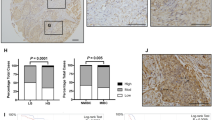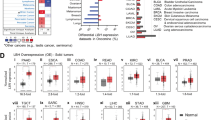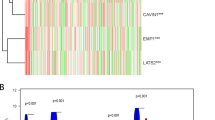Abstract
Deleted in bladder cancer 1 (DBC1) is a candidate gene for the bladder tumour suppressor locus at 9q33.1. The function of the gene is currently unknown but a cross-species sequence comparison suggests an important role, as it is highly evolutionarily conserved. Here, we transfected a nonexpressing human bladder cancer cell line with a set of human DBC1 cDNA constructs. The effect on global expression patterns was assessed using cDNA microarrays. The cell clone with the lowest level of DBC1 expression showed induced expression of 26 genes including plasminogen activator inhibitor 2 (SERPINB5; 4.6-fold), heparin-binding EGF-like growth factor precursor (DTR; 4.2-fold), small proline-rich protein 2B (SPRR2B; 3.6-fold), metallothionein 1 isoforms (MT1B/MT1A/MT-1F; from 2.9- to 3.2-fold), tissue-type plasminogen activator precursor (PLAT; 2.8-fold) and urokinase-type plasminogen activator precursor (PLAU; 2.7-fold). In clustering analysis, both PLAT and PLAU clustered with the functionally related urokinase plasminogen activator surface receptor (PLAUR; 1.9-fold). Furthermore, 14 human bladder tumours were analysed by real-time quantitative PCR using gene-specific primers for selected (n=20) genes. The expression levels of SERPINB5, PLAU, PLAUR and MT1 correlated with the DBC1 levels, suggesting previously unknown involvement of DBC1 in the urokinase-plasminogen pathway.
This is a preview of subscription content, access via your institution
Access options
Subscribe to this journal
Receive 50 print issues and online access
$259.00 per year
only $5.18 per issue
Buy this article
- Purchase on Springer Link
- Instant access to full article PDF
Prices may be subject to local taxes which are calculated during checkout





Similar content being viewed by others
Accession codes
Accessions
Ensembl
References
Bachmann F . (1995). Thromb Haemost 74: 172–179.
Barradas M, Gonos ES, Zebedee Z, Kolettas E, Petropoulou C, Delgado MD et al. (2002). Exp Cell Res 273: 127–137.
Champelovier P, Boucard N, Levacher G, Simon A, Seigneurin D, Praloran V . (2002). Urol Res 30: 301–309.
Cohen RL, Niclas J, Lee WM, Wun TC, Crowley CW, Levinson AD et al. (1989). J Biol Chem 264: 8375–8383.
Eller MS, Yaar M, Ostrom K, Harkness DD, Gilchrest BA . (1995). J Cell Sci 108 (Part 8): 2741–2746.
Foucre D, Bouchet C, Hacene K, Pourreau-Schneider N, Gentile A, Martin PM et al. (1991). Br J Cancer 64: 926–932.
Fujiwara H, Emi M, Nagai H, Ohgaki K, Imoto I, Akimoto M et al. (2001). J Hum Genet 46: 372–377.
Fujiyama C, Jones A, Fuggle S, Bicknell R, Cranston D, Harris AL . (2001). Br J Cancer 84: 558–564.
Habuchi T, Luscombe M, Elder PA, Knowles MA . (1998). Genomics 48: 277–288.
Habuchi T, Takahashi T, Kakinuma H, Wang L, Tsuchiya N, Satoh S et al. (2001). Oncogene 20: 531–537.
Habuchi T, Yoshida O, Knowles MA . (1997). Hum Mol Genet 6: 913–919.
Hamada T, Sasaguri T, Tanimoto A, Arima N, Shimajiri S, Abe T et al. (1996). Biochem Biophys Res Commun 219: 829–834.
Hasui Y, Osada Y . (1997). J Natl Cancer Inst 89: 678–679.
Hudson MA, McReynolds LM . (1997). J Natl Cancer Inst 89: 709–717.
Hurst CD, Fiegler H, Carr P, Williams S, Carter NP, Knowles MA . (2004). Oncogene 23: 2250–2263.
Hurst RE, Waliszewski P, Waliszewska M, Bonner RB, Benbrook DM, Dar A et al. (1999). Adv Exp Med Biol 462: 449–467.
Ioachim EE, Charchanti AV, Stavropoulos NE, Athanassiou ED, Michael MC, Agnantis NJ . (2001). Anticancer Res 21: 1757–1761.
Jensen PH, Cressey LI, Gjertsen BT, Madsen P, Mellgren G, Hokland P et al. (1994). Br J Cancer 70: 834–840.
Kawano H, Nakatani T, Mori T, Ueno S, Fukaya M, Abe A et al. (2004). Mol Brain Res 125: 60–75.
Knowles MA . (1999). Electrophoresis 20: 269–279.
Kondo Y, Kuo SM, Lazo JS . (1994). J Pharmacol Exp Ther 270: 1313–1318.
Marvin KW, George MD, Fujimoto W, Saunders NA, Bernacki SH, Jetten AM . (1992). Proc Natl Acad Sci USA 89: 11026–11030.
Mouton RE, Venable ME . (2000). Mech Ageing Dev 113: 169–181.
Nishiyama H, Gill JH, Pitt E, Kennedy W, Knowles MA . (2001). Oncogene 20: 2956–2964.
Nishiyama H, Takahashi T, Kakehi Y, Habuchi T, Knowles MA . (1999). Genes Chromosomes Cancer 26: 171–175.
Sens MA, Somji S, Lamm DL, Garrett SH, Slovinsky F, Todd JH et al. (2000). Environ Health Perspect 108: 413–418.
Serakinci N, Guldberg P, Burns JS, Abdallah B, Schrodder H, Jensen T et al (2004). Oncogene 23: 5095–5098.
Shelton DN, Chang E, Whittier PS, Choi D, Funk WD . (1999). Curr Biol 9: 939–945.
Simpkins CO . (2000). Cell Mol Biol 46: 465–488.
Stadler WM, Steinberg G, Yang X, Hagos F, Turner C, Olopade OI . (2001). Clin Cancer Res 7: 1676–1682.
Toshiyuki N, Ichiro M . (2004). Mol Brain Res 125: 47–59.
Tsangaris GT, Tzortzatou-Stathopoulou F . (1998). Anticancer Res 18: 2423–2433.
Vandesompele J, De Preter K, Pattyn F, Poppe B, Van Roy N, De Paepe A et al. (2002). Genome Biol 3, research0034.1–0034.11.
Williams SV, Sibley KD, Davies AM, Nishiyama H, Hornigold N, Coulter J et al. (2002). Genes Chromosomes Cancer 34: 86–96.
Wright KO, Messing EM, Reeder JE . (2002). J Urol 168: 2645–2649.
Wright KO, Messing EM, Reeder JE . (2004). Oncogene 23: 82–90.
Yu J, Zhang HY, Ma ZZ, Lu W, Wang YF, Zhu JD . (2003). Cell Res 13: 319–333.
Acknowledgements
This research was supported by Cancer Research UK. We thank the staff of the Sanger Institute Microarray Facility for the supply of arrays, lab protocols, and technical advice (David Vetrie, Cordelia Langford, Adam Whittaker, Neil Sutton), Quantarray/GeneSpring datafiles and all data analysis and databases relating to elements on the arrays (Kate Rice, Rob Andrews, Adam Butler, Harish Chudasama). The microarray consortium is funded by the Wellcome Trust, Cancer Research UK and the Ludwig Institutes of Cancer Research. The human IMAGE cDNA clone collection was obtained from the MRC HGMP Resource Centre (Hinxton, UK). All cDNA clone resequencing was performed by Team 56 at the Sanger Institute. We also appreciate the help extended by Simon Tomlinson from Cancer Research UK in London.
Author information
Authors and Affiliations
Corresponding author
Additional information
Supplementary Information accompanies the paper on Oncogene website (http://www.nature.com/onc).
Rights and permissions
About this article
Cite this article
Louhelainen, J., Hurst, C., Pitt, E. et al. DBC1 re-expression alters the expression of multiple components of the plasminogen pathway. Oncogene 25, 2409–2419 (2006). https://doi.org/10.1038/sj.onc.1209228
Received:
Revised:
Accepted:
Published:
Issue Date:
DOI: https://doi.org/10.1038/sj.onc.1209228
Keywords
This article is cited by
-
Array CGH demonstrates characteristic aberration signatures in human papillary thyroid carcinomas governed by RET/PTC
Oncogene (2008)
-
Frequent hypermethylation of DBC1 in malignant lymphoproliferative neoplasms
Modern Pathology (2008)
-
Molecular pathogenesis of bladder cancer
International Journal of Clinical Oncology (2008)



